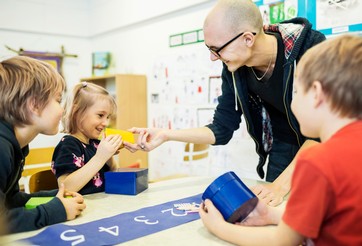Many times, children with ADHD have difficulty adjusting to the school environment. Their symptoms can make school more difficult for them than for other students. Oftentimes, when working with the school, there are things that teachers and parents can discuss as accommodations to help children with ADHD cope better in the classroom.

Here are some educational and behavioral ADHD accommodations:
Extra Time
Allow extra time for certain tasks. ADHD students may work more slowly. Don’t penalize for needed extra time.
Desk Placement
Place it in a location away from distractions. Seat near front of room and away from doorways.
Avoid Distraction
Try to keep the student’s desk away from auditory and visual distracters, such as pencil sharpeners, windows, high traffic areas, or other disruptive students.
Desk Top Organization
Help the student organize activities. When he/she is working, try to see that only the necessary materials needed are out on the desk.
Ensuring Attention
Establish eye contact when giving instructions. Directions and other comments should be crisp and to the point, never wordy and repeated. Give directions auditorily and visually. Arrange to use a nonverbal signal that doesn’t embarrass the student and is known to only the two of you when he/she is off task.

Structure
ADHD students do not handle change well. Keep consistent rules, subjects at the same time, etc. They go from structured to unstructured activities well, but not the reverse.
Division of Work
Divide the student’s work into smaller tasks; print fewer problems on page; give fewer problems/questions or grade only those completed; allow brief breaks between jobs.
Rewards
ADHD students respond well to positive comments and encouragement, and very negatively to criticism/embarrassment.
Assignment Sheets
Try to provide a daily or weekly assignment sheet. Keep parents informed when several assignments are missing so they may assist in getting the work completed or handed in.

Legitimate Movement
Allow the student to move around at appropriate times during the class, by taking note to office, going to the restroom or erasing the board to work off energy. It is very difficult for them to stay seated for a full class period.
Capitalize on Strengths
Recognize the student for some special positive qualities.
Discipline
Must be clear, not wordy, and have rules and consequences. It should be applied without lecturing, nagging, embarrassment or screaming. Allow the ADHD student to keep self-esteem.
Allow Movement Breaks
It can be helpful to have the student deliver messages to the office or return books to the school library. Sometimes, an older peer “buddy” can help by walking up and down a flight of stairs 2-3 times. Ample time to move their body can help certain students greatly.
Alternative Methods
Allow alternative methods for the student to prove that he/she has mastered information and skills, such as through the use of tape recorders, computers, or calculators.
ere are some suggestions for medication in the classroom:
Let your teacher know if medication has been started, and you are worried about side effects. Your child’s teacher may be able to help identify any potentially difficult side effects.
If your child takes medication at school, make sure to work with the school nurse or assigned staff person. Take a labeled bottle of the medication, and provide written directions. School personnel should be in charge of administration, as well as requesting the child goes to the office, as this can be too large a responsibility for many ADHD students.
Since appetite suppression can be common on many medications, it can be helpful to make sure that the student has a series of small snacks throughout the day to make sure s/he has enough calories and nutrients to fuel her body. Snacks could include: a quarter of a peanut butter sandwich, a protein shake, string cheese, etc. Oftentimes, students are most successful if they eat their snack in the school office.
Many ADHD medications can dehydrate students or give them a dry mouth. It may be important for the child to have a water bottle that sh/he can keep at her desk during the day and refill as needed. Trips to the water fountain are likely not sufficient to keep the student hydrated.
It will be important for parents and teachers to work together for the good of the student. At times, it may also be important to alert the teachers of specials classes (art, music, etc.), as well as recess attendants of the accommodations or strategies. And over time, these strategies will need to be refined as the student gets older or as classrooms change.
![]()
